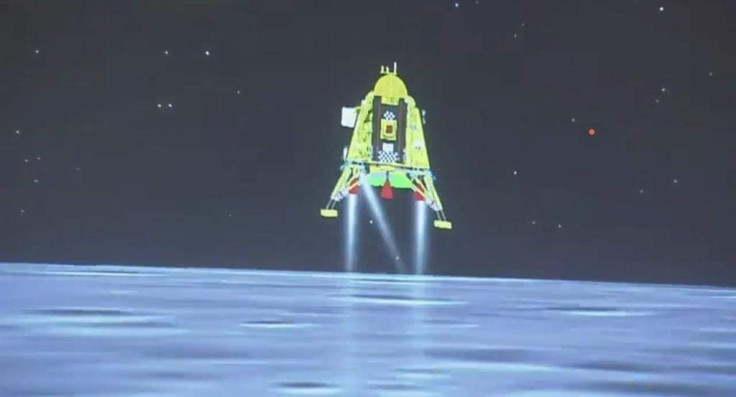India's Chandrayaan-3 achieved the world's first soft landing on the south pole of the moon
India completed the world's first soft landing on the lunar south pole on Wednesday, making it the only nation to land on the far side of the moon thus far.

India has marched ahead in the 21st-century race to the moon, as the Indian lunar mission named Chandrayaan-3 beat Russia to soft land on the far side of the moon on August 23 at 6.03 pm Indian Standard Time.
Upon landing the lander transmitted the message "India I reached my destination and you too", which was tweeted by the Indian Space Research Organisation (ISRO).
Chandrayaan-3 Mission:
— ISRO (@isro) August 23, 2023
'India🇮🇳,
I reached my destination
and you too!'
: Chandrayaan-3
Chandrayaan-3 has successfully
soft-landed on the moon 🌖!.
Congratulations, India🇮🇳!#Chandrayaan_3#Ch3
This is the first time any country in the world has landed a spacecraft on the south pole region of the moon. In 2019, India attempted a soft landing on the lunar south pole with Chandrayaan-2. However, the spacecraft crash-landed on the moon's surface.
It's been four years since then, and now India attempted the same mission with Chandrayaan-3, after improving sensors which made provisions for the lander named Vikram to land even if it lost touch with the spacecraft.
Russia previously attempted the same feat. However, Russia's endeavours ended rather bleakly after the nation lost contact with its spacecraft Luna-25, leading to an eventual crash landing on the southern region of the moon.
This is crucial as India recently joined the Artemis Accord started by the US which seeks to bolster space exploration especially lunar and martial exploration like this successful soft landing.
Way to tackle the challenges of soft landing on the lunar south pole
Chandrayaan-3 was launched on July 14, 2023, and the Vikram lander successfully soft landed in the designated site at the south pole of the moon on August 23.
However, the road to this race to the moon wasn't smooth for India, as the ISRO scientists planned to postpone the soft landing on the lunar south pole if conditions were unfavourable on the landing date. This was announced by the Indian Space Research Organisation, ISRO, a day before the landing on August 22.
ISRO's Space Applications Centre Director Nilesh Desai revealed that the primary agenda of the scientists was to ensure that the health parameters of the lander module were fine as the spacecraft reduced speed on its way to the lunar surface touchdown. In case of problems in the lander module, the soft landing on the lunar south pole would have been postponed to August 27.
The Vikram lander of Chandrayaan-3 tried to touch the lunar surface descending from 30km height at a speed of 1.68km/s. The scientists focussed on gradually reducing the speed of the spacecraft so that the lunar gravitational force doesn't pull it towards the surface, making it crash during the soft landing on the lunar south pole.
On August 21, two days before the successful soft landing, the Indian Space Research Organisation declared that the Chandrayaan-3 lander had made contact with the Chandrayaan-2 orbiter and hence the lander had two orbiters at its disposal.
Chandrayaan-3 Mission:
— ISRO (@isro) August 21, 2023
‘Welcome, buddy!’
Ch-2 orbiter formally welcomed Ch-3 LM.
Two-way communication between the two is established.
MOX has now more routes to reach the LM.
Update: Live telecast of Landing event begins at 17:20 Hrs. IST.#Chandrayaan_3 #Ch3
Desai further revealed how the ISRO scientists started uploading commands two hours before the soft landing in order to analyse the telemetry signals and understand the lunar conditions. The landing would have been postponed at this juncture if the parameters weren't right. The real challenge was the final 17 minutes of the soft landing on the lunar surface as four engine thrusters fired at that time to reduce the speed, said Desai.
When the spacecraft (running on two engines) was 800m away from the lunar surface, the speed was reduced to zero as the lunar gravitational force was the strongest then. At this point, the lander module made its vertical descent from 800m to 150m for a successful touchdown on the lunar surface.
The Vikram lander of Chandrayaan-3 landed at 70 degrees latitude on the moon's south pole on August 23. If the conditions had been unfavourable, ISRO scientists would have made another attempt at a soft landing on the lunar surface 400km away from the original site.
Lunar conditions make it difficult for a soft landing on the moon's south pole. The atmospheric conditions of the lunar south pole make it a difficult spot to land spacecraft.
Earlier, American lunar missions like Apollo and Surveyor had landed near the lunar equator where the lunar surface is flat and not rough like the lunar south pole. Previous Luna moon missions of Russia also landed at the equator.
The lunar south pole is filled with bigger craters and deep trenches. In the absence of sunlight and the temperature dipping to –230°C, soft-landing on the lunar south pole is difficult.
Desai spoke of this when he pointed out the failures of Luna 25 and Chandrayaan-2 which makes the successful landing of Chandrayaan-3 such an extraordinary feat towards the race to the moon.
With this successful landing, India joins the club of elite space-exploring nations that touched down on the moon. It's the fourth country to land on the moon after the USA, Russia and China.
© Copyright IBTimes 2024. All rights reserved.






